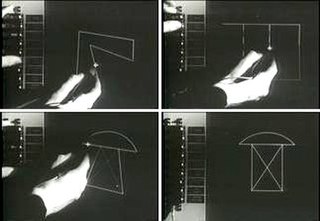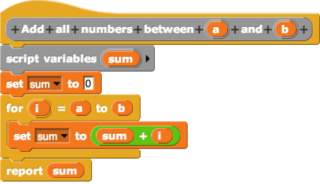Related Research Articles

Sketchpad is a computer program written by Ivan Sutherland in 1963 in the course of his PhD thesis, for which he received the Turing Award in 1988, and the Kyoto Prize in 2012. It pioneered human–computer interaction (HCI), and is considered the ancestor of modern computer-aided design (CAD) programs as well as a major breakthrough in the development of computer graphics in general. For example, the graphical user interface (GUI) was derived from Sketchpad as well as modern object-oriented programming. Using the program, Ivan Sutherland showed that computer graphics could be used for both artistic and technical purposes in addition to demonstrating a novel method of human–computer interaction.

In computing, a visual programming language is any programming language that lets users create programs by manipulating program elements graphically rather than by specifying them textually. A VPL allows programming with visual expressions, spatial arrangements of text and graphic symbols, used either as elements of syntax or secondary notation. For example, many VPLs are based on the idea of "boxes and arrows", where boxes or other screen objects are treated as entities, connected by arrows, lines or arcs which represent relations.
Interaction design, often abbreviated as IxD, is "the practice of designing interactive digital products, environments, systems, and services." Beyond the digital aspect, interaction design is also useful when creating physical (non-digital) products, exploring how a user might interact with it. Common topics of interaction design include design, human–computer interaction, and software development. While interaction design has an interest in form, its main area of focus rests on behavior. Rather than analyzing how things are, interaction design synthesizes and imagines things as they could be. This element of interaction design is what characterizes IxD as a design field as opposed to a science or engineering field.

In human–computer interaction, WIMP stands for "windows, icons, menus, pointer", denoting a style of interaction using these elements of the user interface. Other expansions are sometimes used, such as substituting "mouse" and "mice" for menus, or "pull-down menu" and "pointing" for pointer.
The following outline is provided as an overview of and topical guide to human–computer interaction:

Ben Shneiderman is an American computer scientist, a Distinguished University Professor in the University of Maryland Department of Computer Science, which is part of the University of Maryland College of Computer, Mathematical, and Natural Sciences at the University of Maryland, College Park, and the founding director (1983-2000) of the University of Maryland Human-Computer Interaction Lab. He conducted fundamental research in the field of human–computer interaction, developing new ideas, methods, and tools such as the direct manipulation interface, and his eight rules of design.
Cognitive dimensions or cognitive dimensions of notations are design principles for notations, user interfaces and programming languages, described by researcher Thomas R.G. Green and further researched with Marian Petre. The dimensions can be used to evaluate the usability of an existing information artifact, or as heuristics to guide the design of a new one, and are useful in Human-Computer Interaction design.
Secondary notation is the set of visual cues used to improve the readability of a formal notation. Examples of secondary notation include the syntax highlighting of computer source code, sizes and color codes for easy recognition of consumer symbols such as bank notes or coins, or the regular typographic conventions often found in technical books to highlight sections with the same type of content.
Jock D. Mackinlay is an American information visualization expert and Vice President of Research and Design at Tableau Software. With Stuart K. Card, George G. Robertson and others he invented a number of Information Visualization techniques.
Elizabeth D. "Beth" Mynatt is the Dean of the Khoury College of Computer Sciences at Northeastern University. She is former executive director of the Institute for People and Technology, director of the GVU Center at Georgia Tech, and Regents' and Distinguished Professor in the School of Interactive Computing, all at the Georgia Institute of Technology.
Informatics is the study of computational systems, especially those for data storage and retrieval. According to ACM Europe andInformatics Europe, informatics is synonymous with computer science and computing as a profession, in which the central notion is transformation of information. In other countries, the term "informatics" is used with a different meaning in the context of library science.
Computational musicology is an interdisciplinary research area between musicology and computer science. Computational musicology includes any disciplines that use computers in order to study music. It includes sub-disciplines such as mathematical music theory, computer music, systematic musicology, music information retrieval, computational musicology, digital musicology, sound and music computing, and music informatics. As this area of research is defined by the tools that it uses and its subject matter, research in computational musicology intersects with both the humanities and the sciences. The use of computers in order to study and analyze music generally began in the 1960s, although musicians have been using computers to assist them in the composition of music beginning in the 1950s. Today, computational musicology encompasses a wide range of research topics dealing with the multiple ways music can be represented.

Elizabeth Frances Churchill is a British American psychologist specializing in human-computer interaction (HCI) and social computing. She is a Director of User Experience at Google. She has held a number of positions in the ACM including Secretary Treasurer from 2016-2018 and Executive Vice President from 2018-2020.
Thomas R.G. Green is a British cognitive scientist, and Visiting Professor at the University of York, known for his contribution to cognitive modelling and the development of the concept of cognitive dimensions of notations.
Alan F. Blackwell is a New Zealand-British cognition scientist and professor at the Computer Laboratory, University of Cambridge, known for his work on diagrammatic representation, on data and language modelling, investment modelling, and end-user software engineering.
Heike Hofmann is a statistician and Professor in the Department of Statistics at Iowa State University.
Sarah Ann Douglas is a distinguished computer scientist, known for her work in human-computer interaction (HCI), a field of computer science that she has helped pioneer, and, in particular, pointing devices and haptic interactions, WWW interfaces and bioinformatics, and visualization and visual interfaces. She is a Professor Emerita of Computer and Information Science and a member of the Computational Science Institute at the University of Oregon.
Yvonne Rogers is a British psychologist and computer scientist. She serves as director of the Interaction Centre at University College London. She has authored or contributed to more than 250 publications. Her book Interaction Design: Beyond Human-Computer Interaction written with Jenny Preece and Helen Sharp has sold more than 200,000 copies worldwide and has been translated into six other languages. Her work is described in Encounters with HCI Pioneers: A Personal History and Photo Journal.
Lisa Anthony is an Associate Professor in the Department of Computer & Information Science & Engineering (CISE) at the University of Florida. She is also the director of the Intelligent Natural Interaction Technology Laboratory. Her research interests revolve around developing natural user interfaces to allow for greater human-computer interaction, specifically for children as they develop their cognitive and physical abilities.
Sally A. Fincher is a British Computer Scientist and Emerita Professor of Computing Education at the University of Kent. She was awarded the Suffrage Science award in 2018 the SIGCSE Award for Outstanding Contribution to Computer Science Education in 2010 and a National Teaching Fellowship in 2005.
References
- 1 2 3 Marian Petre publications indexed by Google Scholar
- ↑ Scaife, Mike, and Yvonne Rogers. "External cognition: how do graphical representations work?." International journal of human-computer studies 45.2 (1996): 185-213.
- ↑ Jacko, Julie A., ed. Human Computer Interaction Handbook: Fundamentals, Evolving Technologies, and Emerging Applications. CRC press, 2012.
- ↑ Petre, Marian (1989). Finding a basis for matching programming languages to programming tasks. london.ac.uk (PhD thesis). University College London (University of London). OCLC 927053838. EThOS uk.bl.ethos.252003.
- ↑ Andy Oram, Greg Wilson (2010), Making Software: What Really Works, and Why We Believe It. p. 582.